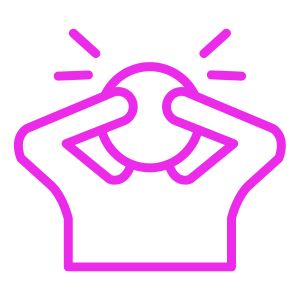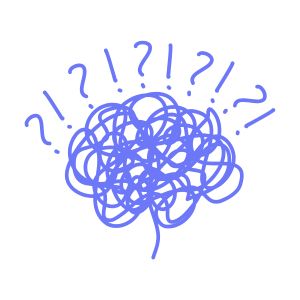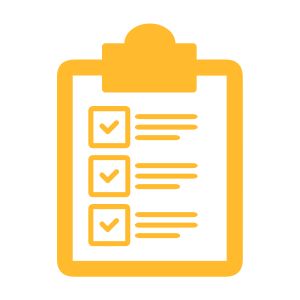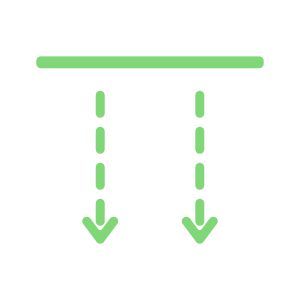How to Reduce Stress and Regain Focus
Feeling overwhelmed by the length of this post? Here’s a brief overview- read through it all, or just click on what you need most!
It’s 4:30: your kids are going to charge through the door in 30… now 29… oh, sht, now it’s 28 minutes. That project you have due in 3 days—the one that you told yourself you would get started on early—remains untouched. The 4 half-written to-do lists that are spread across your desk have a grand total of 3 things crossed off. And then there are the piles: piles of papers to read, piles of bills to pay, piles of mail to sort, and oh, yeah, you really should get dinner started.*
Aaaaaaaaaaa. You feel hopelessly lost, so very alone—and you feel like you screwed up.
Again.
Why do I get Overwhelmed So Easily?!?
The big scary tsunami of feelings that floods your system scrambles your brain, and sends you running for the hills is overwhelm. And it’s not just that your brain makes it harder to get things done that makes you feel more overwhelmed. It’s also that your brain is more prone to getting overwhelmed. Why? Well, Let’s check it out.
Here’s the thing: this isn’t about being “lazy” or “unmotivated.” It’s about how your ADHD brain processes stress, stimulation, and deadlines. When life throws too many demands at you—whether it’s noisy kids, looming deadlines, or just the chaos of everyday responsibilities—it all piles up faster than your brain can sort through it. And without an internal filter to prioritize, everything feels equally urgent.
Even tasks you care about deeply can feel impossible to start, leaving you stuck in a cycle of avoidance, guilt, and frustration. The louder those feelings get, the harder it becomes to take the first step until overwhelm turns into a full-on shutdown.
You’re not alone in this. Overwhelm is one of the most common challenges for adults with ADHD. And it’s not just about juggling responsibilities—it’s about learning how to manage the unique ways your ADHD brain experiences and reacts to the world.
But here’s the good news: overwhelm is manageable. By understanding how it works, why it happens, and what you can do to calm your system, you can break free from this cycle and regain control—even when life feels like it’s coming at you a million miles an hour.
ADHD and Overwhelm: The Frantic Spiral
Everyone gets overwhelmed. Every. Single. Person. ADHDers don’t have the market cornered on that. But ADHD brains not only get overwhelmed more often, but they also get MORE overwhelmed than other brains. And, actually, it doesn’t end there—because when ADHD brains get overwhelmed, they’re more likely to spiral—tumbling down, head-over-heels, smack into what Brendan Mahon calls the ADHD Wall of Awful.
What’s a wall of awful?
You know it—it’s that wall that separates you from what you need to do. It’s been built up over the years—each brick crafted by every experience of criticism, self-doubt, unreached potential, failed intentions, and missed opportunities throughout your life. It’s your history of struggle that comes surging back the second, even a whiff of uncertainty heads your way.
And because your ADHD system feels feelings full force, this wall of awful slams into you with the intensity of a bulldozer at full speed—leaving you huddled in a corner feeling like nothing could or even should be done.
For adults with ADHD, overwhelm doesn’t just show up as stress or busyness—it creates a heavy emotional and mental barrier that feels impossible to overcome. This Wall of Awful isn’t just a metaphor; it’s an accumulation of years of frustration, setbacks, and perceived failures that your ADHD brain remembers all too well.
Each brick represents a past moment when you struggled: unfinished tasks, harsh feedback, missed opportunities, or criticism from others—and even yourself. With ADHD, these moments don’t just fade into the background; they linger and resurface every time you face a new challenge, making the wall feel taller and more impenetrable with every experience.
Adding to the weight of the wall is the ADHD brain’s tendency to process emotions with overwhelming intensity. Small frustrations or uncertainties can hit like a tidal wave, compounding the feelings of failure, self-doubt, or shame. What starts as a single task, like sending an email or organizing your to-do list, suddenly feels like an insurmountable obstacle.
And the spiral doesn’t stop there. As your brain gets flooded with these emotions, the ability to think clearly and prioritize shuts down. It’s not that you don’t care or aren’t trying—it’s that the emotional weight of the Wall of Awful hijacks your brain’s ability to take action.
But here’s the truth: the wall isn’t as permanent as it feels. Brick by brick, it can be dismantled. One strategy at a time, one step forward at a time, you can learn to climb over—or even break through—the wall. Recognizing it for what it is (a temporary barrier, not an insurmountable one) is the first step in taking back control.
Why Are ADHD Brains More Prone to More Frequent and Bigger Overwhelm?
It all comes back to the filter. ADHD brains don’t filter information, stimulation, and other incoming data. It doesn’t sort out the unimportant things, leaving you to only have to deal with the key details. Instead, your brain is smacked with every single piece of data that comes your way. That’s a lot. And, because your brain also doesn’t regulate the intensity of your feelings very well, it feels and experiences that wave of data full force—all day, every day.
This lack of filtering creates a constant sense of overload. Your brain doesn’t have a system to quickly decide, “This can wait,” or “This isn’t important.” Instead, everything feels urgent and equally demanding. Whether it’s the sound of someone typing next to you, the laundry that needs folding, or an email notification, it all rushes in at once, bombarding your already busy mind.
On top of this, ADHD brains are wired to respond to novelty and stimulation. This means that distractions—like a text alert, a sudden thought, or even a bird outside your window—are incredibly hard to ignore. Each new input pulls your focus away, making it harder to stay on track or make progress on the task at hand.
And because emotional regulation is also a challenge, every piece of incoming data doesn’t just exist—it comes with a strong emotional response. That loud noise? It might spark frustration. The growing to-do list? A wave of panic. Over time, these emotional waves compound the overwhelm, leaving you feeling physically and mentally drained.
Living with this unfiltered flood of information, emotions, and distractions is exhausting. But it’s also important to remember that ADHD brains can learn to manage these challenges. By using external tools, such as task organizers or calming techniques, you can begin to create the structure your brain craves.
What Overwhelms the ADHD Brain?
Because the ADHD brain doesn’t filter information or stimulation. And because it struggles to order, prioritize, and organize; it can be overwhelmed by almost anything in life. But these are the top 6 forms of overwhelm I most often see:
Too Much Stimulation: ADHD Overstimulation
The filterless ADHD brain doesn’t tune out information coming in as other brains do. So it all comes in, it all has to be processed, and it all floods the system. Constantly. This means the dog barking hello, the kids fighting in the next room, and the flashing lights in the corner hit your brain full force. Causing things like irritation, headaches, anger, an overwhelming desire to flee or lash out. To learn more about overstimulation check out Why am I so Sensitive?
ADHD overstimulation doesn’t just come from loud noises or chaotic environments—it can also stem from seemingly small, cumulative sensory inputs. The feel of your clothes, the glare of a screen, or even a subtle but persistent hum of a machine can amplify until it pushes your sensory system over the edge. What starts as minor irritations can snowball into full-on sensory overwhelm before you even realize what’s happening.
Too Many Thoughts: Cognitive Overwhelm
Your brain thinks. It thinks all the time, and it thinks all the thoughts. It pinballs around, having thought after thought after thought. Now, let’s not forget that there’s some benefit here—some of those thoughts are incredible. Some of those thoughts can change the world. But let’s also be real—if your brain can’t finish the thought, it’s pretty hard to enact it.
This is where the overwhelm comes in because it’s exhausting trying to follow each and every pinball thought. So after trying for a bit, you then try to choose which one needs to be followed to its full and beautiful conclusion. But all of that effort? That’s executive functioning effort and your executive functioning system—it’s going to wear out its supply quickly, leaving you just with a bunch of frantic pinballs.
Cognitive overwhelm doesn’t just leave you exhausted—it can also feel isolating. Many adults with ADHD report that their pinball thoughts are so relentless that they’re unsure how to explain them to others. This disconnect can make asking for help harder, even though verbalizing those thoughts often lightens the load.
Too Many Feelings: Emotional Overwhelm
Because ADHD is, at its heart, an issue with regulation, ADHD brains struggle to feel anything just a little bit. It gets bowled over, flooded, and submerged by the feelings it feels. The feelings are either ON or OFF and when a brain gets flooded by feelings—particularly those survival feelings like fear, anxiety, worry, or dread—it moves into fight/flight and shuts down your rational brain. When this happens, it’s not even that you’re NOT thinking your way through the situation, but you CAN’T think your way through it.
What makes emotional overwhelm particularly challenging is its unpredictability. You might wake up feeling fine, only to have a single comment, unexpected task, or fleeting memory trigger a tidal wave of emotions. When the ADHD brain floods with feelings, it doesn’t just process them—it amplifies them, making it feel impossible to focus or move forward until the emotional wave subsides.
Too Many Tasks: To-Do List Overwhelm
Because initiation, prioritization, and organization are all issues for ADHD, tasks tend to languish on to-do lists. And the more items you have on a list, the harder it is to do any of them. That’s if everything is even on a to-do list, to begin with. But, so often, they’re not—instead, 4 are on a post-it note on your computer screen, 8 are in a notebook at the bottom of your bag, 6 are on a list in the kitchen and then about 42 are running around your head, keeping you up at night and suddenly occurring to you at the most inopportune times. Trying to find your way through all those tasks? That’s to-do list overwhelm.
Another challenge with to-do list overwhelm is the brain’s tendency to prioritize urgency over importance. This means that tasks with looming deadlines (even minor ones) demand attention, while more significant, long-term projects often get sidelined. The result? You’re always busy but rarely feel like you’re making meaningful progress.
Too Much Stuff: Clutter Overwhelm
ADHD brains struggle to finish a task to completion. This means that bags drop at the front door, keys hang in the lock, and projects that are 60-80% done collect dust in the corner. Combine this with a brain that doesn’t feel motivated to act by things like “it’d be nice if it were tidy around here” or even “my day would be so much easier tomorrow if I knew where everything was,” and you can get a very cluttered and messy house. All this stuff can overwhelm your sensory system and make it hard to sort your way through your tasks or your day. Feel constantly overwhelmed by all your clutter? Check out this post for an ADHD-friendly strategy for tidying up.
Clutter isn’t just about physical disorganization—it can also create mental noise. ADHD brains are constantly processing their environment, and the sight of unfinished projects, misplaced items, or scattered belongings becomes a visual reminder of all the things left undone. This unspoken pressure adds to the weight of overwhelm, making it even harder to tackle the mess.
Too Many Logistics: Logistical Overwhelm
Cooking an elaborate dinner, planning a multi-city trip, hell—even just making your way through a grocery store—all of these things require endless logistics. Micro-decisions, planning, organizing, ordering, and thinking through consequences. Each one of those logistics is drawing from that executive functioning bank and those withdrawals are going to start to add up fast. When your executive bank account is running low, your brain is going to suddenly start to feel overwhelmed—the decisions and details are going to start to swirl around your brain, leaving you feeling confused, flooded, and like you just want to shut down and escape.
Logistical overwhelm is especially tricky because it sneaks up on you. A simple grocery store trip, for example, might seem manageable at first, but once you factor in navigating aisles, remembering your list, and making choices about brands or prices, it can quickly become overwhelming. Layer on interruptions—like a phone call or a crying child—and the mental energy required feels impossible to sustain.
What to Do When You Feel Overwhelmed
When you begin to feel that tell-tale feeling of overwhelm—the one that makes you want to run—not walk—back to your bed and pull your covers over your head. When you want to call your mommy in the middle of the day. When you want to put your hands over your ears and yell-sing, “la-la-la” like a 4-year-old ignoring that very same mom—these are all signals your brain has gotten flooded. When this happens, it’s like the grown-up inside your brain has turned off, and the toddler has taken over. And just like when your 3-year-old throws themselves on the floor—now is not the time to argue. Now is the time to calm down your system and get your inner grown-up back on board.
In these moments, it’s crucial to remember that overwhelm isn’t permanent, even if it feels that way in the moment. While it may seem impossible to take action when your brain is flooded, the first step isn’t about solving the problem—it’s about interrupting the spiral. Think of it as hitting the “pause” button to give yourself a chance to reset, calm your system, and bring your thinking brain back online before taking the next step.
The 4-Step Process for Taking Control of Overwhelm
1. Notice the Signs
What are your personal signs of overwhelm? Do you get a pounding headache? Does your vision blur? Does your thinking go foggy? Do you feel the need to run screaming from the room or jump back in bed and pull the covers over your head? Think back to the last few times you got overwhelmed—what did it feel like? What were the feelings in your body? Those are your red flags. The more you’re aware of them, the sooner you can notice when overwhelm is beginning. The sooner you deal with it, the less consuming it will be.
Learning to recognize the early signs of overwhelm is one of the most powerful tools you can develop. Think of it as creating a “roadmap” of your brain’s signals—whether it’s physical (like a racing heart), emotional (like irritability), or mental (like foggy thinking). When you notice these patterns early, you have a chance to intervene before the overwhelm grows. Journaling or keeping a “trigger log” can help you identify recurring patterns over time.
2. Step Away
Once you notice the signs—step away from the situation. Excuse yourself to the bathroom, hide in a closet, take a walk—whatever you need to do to give yourself space from the things that are overwhelming you. (Hint: if it’s cognitive overwhelm—a loud music dance break, walk outside, or hot shower can all help calm—or drown out—the relentless flood of thoughts.)
Stepping away isn’t about avoiding the problem; it’s about creating space to breathe. Even a two-minute break to close your eyes or focus on your breath can begin to regulate your nervous system. Physical movement, like shaking out your arms, pacing, or dancing, can also help release built-up tension and reset your brain.
3. Identify the Overwhelm
Figure out which type of overwhelm was triggering you—was it too many thoughts? A flood of feelings? Too many logistics? Check out the chart and find your next step.
Once you’ve calmed your system, it’s easier to pinpoint what’s really going on. Ask yourself: What triggered this overwhelm? Was it external, like a loud environment or a tight deadline? Or internal, like a wave of anxious thoughts or an emotionally charged situation? By identifying the source, you can begin to untangle the overwhelm and choose a targeted strategy to address it.
4. Take the Next Step
Once you’ve figured out what the overwhelm is, now use the chart below to choose the next step that starts chipping away at that overwhelm beast.
The next step doesn’t have to be a grand solution—it just has to be small and actionable. Break the task into tiny, manageable pieces. For example, if writing an email feels overwhelming, start with something as small as opening your inbox or writing the first sentence. Each small success creates momentum, helping you rebuild confidence and move forward.
And don’t be afraid to lean on tools like timers, checklists, or even a trusted friend to help you stay focused. Overwhelm may feel like a massive wave, but with the right strategies, you can take control and ride it out.
ADHD Overwhelm Strategies
Finding effective ADHD overwhelm strategies is essential when the flood of tasks, thoughts, or emotions becomes too much to handle. Whether you’re dealing with overstimulation, cognitive overload, emotional overwhelm, or a daunting to-do list, these targeted strategies can help you regain control and calm your ADHD brain.

Overstimulation
Overstimulation is one of the most common triggers for ADHD overwhelm. When your brain is flooded with too much sensory input, like noise, bright lights, or constant interruptions, it can be hard to think clearly or make decisions.
What to do: Step away from the source of stimulation. Find a quiet space and limit overwhelming input. Then, take several long, slow, deep breaths to calm your nervous system. This simple technique can help quiet the noise in your brain and restore focus.

Cognitive Overwhelm
Cognitive overwhelm happens when your ADHD brain is spinning with too many thoughts at once. The constant pinballing of ideas can leave you mentally exhausted and unsure of where to start.
What to do: Get a large sheet of paper and do a brain dump. Write down every single thought—don’t worry about making it linear or organized. Just get it all out of your head and onto paper. Once your thoughts are down, go back and start sorting through them. This process creates mental clarity and helps reduce the cognitive load.

Emotional Overwhelm
Emotional overwhelm is a hallmark of ADHD, where feelings hit hard and fast. When anxiety, frustration, or fear takes over, it’s easy to feel completely flooded and stuck.
What to do: Soothe your senses. Use a sense-soothing menu to identify strategies that help calm your emotions, such as listening to relaxing music, using a weighted blanket, or focusing on deep breathing. Don’t fight or suppress your feelings—let them come, but take steps to soothe yourself as they do. Once the emotional wave has passed, you’ll be better equipped to think rationally and address the situation.

To-Do List Overwhelm
For many adults with ADHD, a long to-do list can be paralyzing. Instead of motivating action, an overwhelming list often leads to avoidance, guilt, and even more tasks piling up.
What to do: Gather all your scattered lists and combine them into one master list. From there:
- Identify items that can be passed off to someone else, crossed off, or deemed unimportant—and do those first.
- Highlight the 3 most important tasks remaining.
- Break the hardest task into micro-steps. For example, if you need to send an email:
- Step 1: Find the recipient’s email address.
- Step 2: Brainstorm your main points.
- Step 3: Write the first draft outside of your email platform.
- Step 4: Copy, paste, and edit the draft.
- Step 5: Press send.
Breaking tasks into bite-sized actions makes them feel less daunting and gives you a sense of progress with each small success.
Still feeling stuck? Check out this post on how to get the right stuff done, even when ADHD overwhelm feels impossible.

Clutter Overwhelm
Choose one spot—your desk, your kitchen island, your bed—any spot. Then start the ADHD-friendly 3-step process to tidying your home. Believe me. It works.
Once you’ve tackled one area, celebrate the win—it’s a big deal! Small successes like these build momentum and make the next area feel less overwhelming.

Logistical Overwhelm
When the logistics of a situation are making your head swim, try stepping away and writing it down. Imagine yourself walking through each part of the process and writing down each step. From there—what decision, plan, or detail needs to be figured out on each step? Still feeling swamped? Bring in backup. Sometimes a fresh perspective can help add that one lens that brings it all into focus.
Visualizing the process step by step reduces the mental clutter and helps clarify where to begin. Using tools like checklists or apps can also simplify logistics and keep you on track.
Tips for When You’re Feeling Overwhelmed
- Watch your self-talk. The overwhelm is not your fault. It’s not a signal of who you are as a person. It is a sign of too much going on around you or too much flooding into your brain. Name it for what it i, and don’t make it be something about you.
Negative self-talk can make overwhelm feel heavier and harder to manage. Instead, try replacing critical thoughts with affirmations like, “This is hard right now, but I can handle it one step at a time.” Practicing self-compassion reminds your ADHD brain that setbacks are normal and temporary.
- Step away. You won’t be able to find your balance again while the waves of overwhelm keep crashing on you. Step away, get some space, and allow your system to re-calibrate. Then, and only then, do you want to start to think about how to find your way through it.
Stepping away doesn’t mean quitting—it means giving yourself the space to reset. Even a five-minute walk or a moment of silence can disrupt the cycle of overwhelm and give your brain the clarity it needs to refocus.
- Breathe. When your system is overwhelmed by either internal or external stimulation, it can feel like it’s under constant fire. Once you get some space, allow your nervous system a chance to calm down, take several long, slow, deep breaths to quiet the fight/flight, and bring your thinking brain back on board.
Deep breathing doesn’t just help in the moment—it’s a proven way to train your nervous system to handle stress better over time. Try pairing deep breathing with grounding techniques like focusing on your senses to anchor yourself in the present.
- Give yourself a break. Continuing to try to plug along. Pushing yourself through to work in the middle of overwhelm is not only mean but also likely fruitless. Give yourself a break, take the time you need to recalibrate, and then come back—you will be happier and more productive if you do.
Remember, rest isn’t laziness—it’s a necessary reset for your ADHD brain. Taking breaks regularly can prevent future overwhelm and help you return to tasks with more energy and focus.
The fact that you get overwhelmed is based in your brain, NOT your character. Beating yourself up for your overwhelm or getting mad at yourself for it will only make it worse. Give yourself a break. You deserve it, and your brain needs it.
But, also—that’s easier said than done, and overwhelm can so often lead to shame, anger, and other strong, hard-to-manage emotions. And ADHD brains? They’re more likely to have a hard time dealing with these big feelings.
Recognizing these emotions as part of how ADHD works can help reduce the shame that often accompanies overwhelm. Seeking support from a therapist or loved one can also provide tools to better manage these intense feelings.
We’re Here to Support You—One Step at a Time
Ready to tackle overwhelm and regain control of your ADHD journey? Remember, consistent actions build momentum—and before you know it, the mountain becomes manageable.
Take the first step today by booking a consultation with one of our ADHD specialists. Let’s work together to create strategies that help you feel empowered, focused, and in control.



